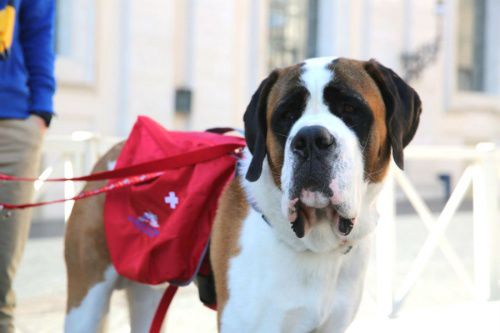While Pope Francis might have chastised animal-lovers who treat their pets better than people in last week’s general audience, that didn’t stop him from giving a good pat on the head to Magnum — the Saint Bernard with VIP access to today’s audience.
Magnum is quite literally a “Great Saint Bernard.” Bred by an order of priests known as Augustinian Canons, he was born on the Great Saint Bernard Pass, one of the highest passes in the Alps connecting Switzerland and Italy.
He is also a descendant of Barry, one of the most famous St. Bernard rescue dogs known to history.
Long before Beethoven drooled his way onto the big screen, Saint Bernard dogs had been made famous by the Augustinians for a more noble cause: saving lives.
Since the early 18th century, the Augustinian monks who lived in the treacherous Great Saint Bernard Pass kept the dogs in order to help them on their rescue missions to save stranded travelers after bad snowstorms.
Sitting just over 8,000 feet above sea level, the pass stretches 49 miles and in previous centuries was an extremely dangerous route to take. So in order to help travelers who met trouble along the way, Augustine monk St. Bernard de Menthon founded a refuge and monastery around the year 1050.
It wasn’t until sometime between the years 1660-1670 that the monks at what become known as the “Great St. Bernard Hospice” acquired their first dogs, who for the next 150 years served as both companions, scouts and rescuers for travelers in trouble.
A “hospice” at that time was a lodging for travelers. If the dogs found an injured traveler stuck in the snow, one would typically lay on top of the person to keep them warm, while another would return to the hospice to alert the monks that someone was stranded.
Perhaps the most famous of the St. Bernard rescue dogs was Barry, who lived in the monastery from around 1800-1812, and saved the lives of more than 40 people. In total, the St. Bernard rescue dogs are credited with saving roughly 2,000 lives.
Magnum was present at the Pope’s general audience through the help of UNESCO, who not only wanted to honor the memory of his the dog’s famous ancestor, but also garner support for their effort to declare the Great Saint Bernard Pass a World Heritage Site.
Pioneering the effort is the “Barry Foundation,” which was established in 2005 to take over the breeding of the dogs and to ensure they have some social occupation.
With the support of Pierre-Yves Fux, Switzerland’s Ambassador to the Holy See, the foundation was able to organize the visit to Rome.
In addition to Magnum, others accompanying him to meet the Pope included a Swiss-Italian delegation composed of politicians and representatives of various organizations linked to the dogs and the Saint Bernard Pass.
Pope Francis met this St. Bernard today at the general audience. Read the story at CNA: https://t.co/nbMfHb2mDh pic.twitter.com/gxs7AsXRSp
— Catholic News Agency (@cnalive) May 18, 2016rn

